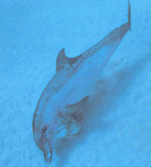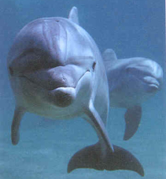Dolphin Sounds
At Dolphin Encounters, our animals produce a variety of sounds. Most of the sounds were offered by the dolphins during training and were later "captured on cue" such that trainers could ask for each specific vocalization with a unique signal. As you learn more about how dolphins produce sounds, move your mouse onto each sound icon  to hear some of the vocalizations that our animals make.
to hear some of the vocalizations that our animals make.
Bottlenose dolphins identify themselves with a  Signature Whistle. However, scientists have found no evidence of a dolphin language. For example, a mother dolphin may whistle to her calf almost continually for several days after giving birth. This acoustic imprinting helps the calf learn to identify its mother.
Signature Whistle. However, scientists have found no evidence of a dolphin language. For example, a mother dolphin may whistle to her calf almost continually for several days after giving birth. This acoustic imprinting helps the calf learn to identify its mother.
Besides whistles, dolphins produce clicks and sounds that resemble moans, trills, grunts and squeaks. They make these sounds at any time and at considerable depths. Sounds vary in volume, wavelength, frequency and pattern. Bottlenose dolphins produce sounds ranging from 0.25 to 150kHz. The lower frequency vocalizations (0.25 to 50 kHz) are likely used in social communication. Higher frequency clicks (40 to 150 kHz) are primarily used in echolocation.
 Motorbike
Motorbike
Dolphins rely heavily on sound production and reception to navigate, communicate, and hunt in dark or murky waters. Under these conditions, sight is of little use. Bottlenose dolphins can produce clicks and whistles at the same time.
 Whistling
Whistling
As with all toothed whales, a dolphin’s larynx does not possess vocal cords, but researchers have theorized that at least some sound production originates from the larynx. Early studies suggested that "whistles" were generated in the larynx while "clicks" were produced in the nasal sac region. Technological advances in bio-acoustic research enable scientists to better explore the nasal region. Studies suggest that a tissue complex in the nasal region is most likely the site of all sound production. Movements of air in the trachea and nasal sacs probably produce sounds. (Dolphin Discovery: Bottlenose Dolphin Training and Interaction; Sea World, 1999.)
 Yelling
Yelling
Millions of years ago, toothed whales developed echolocation, a sensory faculty that enabled them to survive in often murky and dark aquatic environments. It is a process in which an organism probes its environment by emitting sounds and listening to echoes as the sounds bounce off objects in the environment. With sound traveling better in water than electromagnetic, thermal, chemical, or light signals, it was advantageous for dolphins to evolve echolocation, a capability in which acoustic energy is used, in a sense, to see underwater. Synonymous with the term "sonar" (sound navigation and ranging) and used interchangeably, dolphin echolocation is considered to be the most advanced sonar capability, unrivaled by any sonar system on Earth, man-made or natural.
 Fog Horn
Fog Horn
 Dolphin scanning sandy bottom for hidden fish.
Dolphin scanning sandy bottom for hidden fish.
This ideal evolutionary adaptation has contributed to the success of cetacean hunting and feeding and their survival as a species overall. As a result, dolphins are especially good in finding and identifying prey in shallow and noisy coastal waters containing rocks and other objects. By using their sonar ability, dolphins are able to detect and recognize prey that have burrowed up to 1 ½ feet into sandy ocean or river bottoms – a talent that has stirred the imagination (and envy) of designers of manmade sonar.
Researchers, documenting the behavior of Atlantic bottlenose dolphins foraging for buried prey along the banks of Grand Bahama Island, have found that these dolphins, while swimming close to the bottom searching for prey, typically move their heads in a scanning motion, either swinging their snout back and forth or moving their heads in a circular motion as they emit sonar sounds. They have been observed digging as deep as 18 inches into the sand to secure a prey. Such a capability is unparalleled in the annals of human sonar development.
 Scream
Scream
The process of echolocation begins when dolphins emit very short sonar pulses called clicks, which are typically less than 50-70 millionth of a second long. The clicks are emitted from the melon of the dolphin in a narrow beam. A special fat in the melon called lipid helps to focus the clicks into a beam. The echoes that are reflected off the object are then received by the lower jaws. They enter through certain parts of the lower jaw and are directed to ear bones by lipid fat channels. The characteristics of the echoes are then transmitted direct to the brain.
 Dolphins can emit sound strong enough to stun their prey.
Dolphins can emit sound strong enough to stun their prey.
The short echolocation clicks used by dolphins can encode a considerable amount of information on an ensonified object – much more information than is possible from signals of longer duration that are emitted by manned sonar. Underwater sounds can penetrate objects, producing echoes from the portion of the object as well as from other surfaces within the object. This provides dolphins with a way to gain more information than if only a simple reflection occurred at the front of the object.
 Raspberry
Raspberry
Dolphins are extremely mobile creatures and can therefore direct their sonar signals on an object from many different orientations, with slightly different bits of information being returned at each orientation; and since the echolocation clicks are so brief and numerous, the multiple reflections from internal surfaces return to the animal as distinct entities and are used by the dolphin to distinguish between different types of objects. Since they possess extremely good auditory-spatial memory, it seems that they are able to "remember" all the important information received from the echoes taken from different positions and orientations as they navigate and scan their environment.
 The melon or forehead is used to focus sounds used for sonar.
The melon or forehead is used to focus sounds used for sonar.
Dolphins’ extremely high mobility and good auditory spatial memory are capabilities that enhance their use of echolocation. With much of the dolphin’s large brain (which is slightly larger than the human brain) devoted to acoustic signal processing, we can better understand the evolutionary importance of this extraordinary sensory faculty.
Yet no one feature in the process of echolocation is more important than the other. Dolphin sonar must be considered as a complete system, well adapted to the dolphin’s overall objective finding prey, avoiding predators, and avoiding dangerous environments. (Excerpted from "Dolphins" by Tim Cahill; article by WhitlowAu, Ph. D; 2000.)

